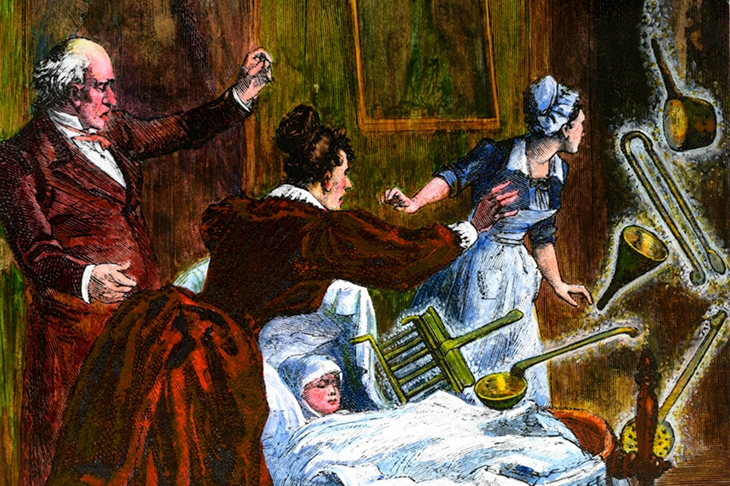There are fashions in the paranormal as in everything else. Since the famous Enfield hauntings of the late 1970s, poltergeists seem to have gone quiet, or at least unreported; but before then they were everywhere. In 1938, poltergeists kicked off in Thornton Heath, Surrey, and a Jewish-Hungarian journalist and psychic investigator, Nandor Fodor, was alerted to strange happenings in the home of a 34-year-old housewife there.
The list of happenings is familiar in all poltergeist stories. Furniture moves, light fittings shatter, crockery, money, knick knacks, even small pictures are thrown through the air, sometimes seemingly aimed directly at individuals.
Alma Fielding and her husband Les were ill at the time the hauntings began, she with a kidney infection, he with haemorrhaging after tooth extraction, both with high temperatures. But when they recovered, the poltergeist did not depart. Neighbours got wind, and hung about outside, so inevitably the press was alerted too, and the Sunday Pictorial, noted for its popular shock-horror stories, sent reporters down. As Mrs Fielding opened the door to them
they saw an egg fly down the corridor, to land a few yards from their feet. As she led them to the kitchen, a pink china dog rattled to the floor and a sharp-bladed tin-opener cut through the air.
Some things can be done by trickery – but surely not moving a mahogany chest of drawers?
The Pictorial’s subsequent headline was: ‘This is the most extraordinary front-page story we have ever printed.’
Fodor was desperate to visit the house, to witness something — anything — as proof of the paranormal. He was a serious psychic researcher, trying to be open-minded; but he was gullible, as they all are. He befriended, and spent a lot of time with, Alma, witnessing numerous inexplicable incidents.
The history of spiritualism has always been rife with fraud and trickery; but although Fodor was longing for evidence, he was not a bad man, and he involved Alma in other forms of psychic activity. He introduced her to the International Institute for Psychic Research, which gathered around it rich, lonely society women and cranks, as well as the deranged and downright dishonest. Alma performed at seances, went into trances and spoke in the voice of a male spirit guide. Objects appeared —combs, scent bottles, fresh flowers — and volunteer members watched her closely. Once or twice their suspicions were aroused, but they saw nothing untoward and believed she was genuine.
When Fodor got to know her better, one or two scales fell from his eyes, but at first not the full set. Alma was gradually revealed as a neurotic, with hidden terrors and deeply repressed past experiences. She had appalling nightmares, claimed that demons attacked and seduced her in her sleep, and was prone to outbursts of rage and wild incoherence. Yet Fodor and others believed the powers she summoned to life were real and their activities not faked.
As Alma gained confidence in showing off to her audiences, however, her guard slipped, and she was caught out hiding objects about her person to deceive even those who had searched her in advance. Still, a little fraud when she was determined to impress surely did not invalidate all her experiences over a long time, especially the poltergeist activity in her home.
Or did it? Some things could be done by trickery — but not the moving of heavy furniture, witnessed by several people. The pulling of near-invisible thread could topple a vase from a shelf but could it move a mahogany chest of drawers?
The story is familiar to anyone who has gone very far into the annals of psychic research. Everyone wanted to believe, just as all the grieving wives and mothers of young men killed in the Great War consulted mediums obsessively in an effort to make contact with their beloved dead. People see what they want to see.
This is not really a story of the supernatural. It never is. It is one about a profoundly disturbed woman who had suffered terrible abuse in her past and repressed her violent emotions deeply. She needed expert psychiatric help; but that was unavailable, though Fodor consulted Sigmund Freud, who had no doubt about her mental and psychological state.
Apart from the revealing of Alma Fielding’s past and its explanation of her condition, this is a largely a story of gullibility: the lure of the vaguely exotic in bored and lonely lives. It is sad, pathetic but not really frightening.
The tale of the Enfield poltergeist made an excellent television series, with the creepy actor Timothy Spall brilliantly cast as the chief investigator; and Alma Fielding’s story is perfectly set up to make one similar. Kate Summerscale gives the best clue to how she sees it all in her quotation from Agatha Christie at the beginning of Part One: ‘Nowadays we find that nearly everything comes from within — from our subconscious self.’







Comments